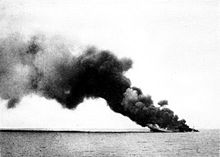
HMS Kingston was a K-class destroyer of the Royal Navy.

The C and D class was a group of 14 destroyers built for the Royal Navy in the early 1930s. As in previous years, it was originally intended to order a complete flotilla comprising eight destroyers—plus a flotilla leader as the ninth unit—in each year. However, only four ships—plus a leader—were ordered under the 1929–1930 Programme as the C class. The other four ships planned for the C class were never ordered as an economy measure and disarmament gesture by the Labour government of Ramsay MacDonald. A complete flotilla—the 'D' class—was ordered under the 1930–1931 Programme.
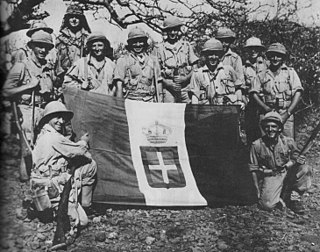
The East African campaign was fought in East Africa during the Second World War by Allies of World War II, mainly from the British Empire, against Italy and its colony of Italian East Africa, between June 1940 and November 1941. The British Middle East Command with troops from the United Kingdom, South Africa, British India, Uganda Protectorate, Kenya, Somaliland, West Africa, Northern and Southern Rhodesia, Sudan and Nyasaland participated in the campaign. These were joined by the Allied Force Publique of Belgian Congo, Imperial Ethiopian Arbegnoch and a small unit of Free French Forces.

The Regia Marina (RM) or Royal Italian Navy was the navy of the Kingdom of Italy from 1861 to 1946. In 1946, with the birth of the Italian Republic, the Regia Marina changed its name to Marina Militare.

The Battle of the Mediterranean was the name given to the naval campaign fought in the Mediterranean Sea during World War II, from 10 June 1940 to 2 May 1945.
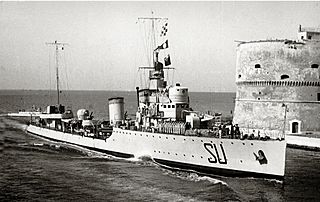
The Sauro class were a group of four destroyers built for the Regia Marina in the late 1920s. They were based in the Red Sea Italian colony of Eritrea and all fought in World War II being sunk during the East African Campaign in 1941.
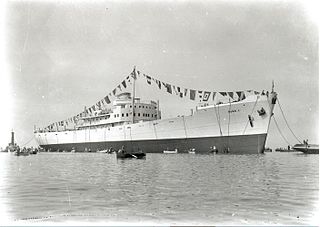
The Italian ship Ramb I was a pre-war "banana boat" converted to an auxiliary cruiser in World War II. Ramb I operated as an armed merchant in the Red Sea and was ordered to sail to Japan after the fall of Massawa to the Allies. She was sunk in the Indian Ocean before she could reach her intended destination.

Vasilefs Georgios was the lead ship of her class of two destroyers built for the Royal Hellenic Navy before the Second World War. Flagship of the navy's Destroyer Flotilla, she participated in the Greco-Italian War in 1940–1941, escorting convoys and unsuccessfully attacking Italian shipping in the Adriatic Sea. While under repair during the Axis invasion of Greece in 1941, Vasilefs Georgios sank when the floating drydock that she was in was either scuttled or sunk by German aircraft.
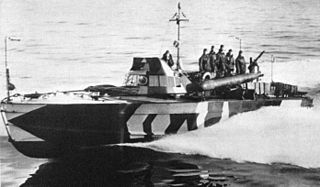
Motoscafo armato silurante, alternatively Motoscafo antisommergibili and commonly abbreviated as MAS, was a class of fast torpedo-armed vessels used by the Regia Marina during World War I and World War II. Originally, "MAS" referred to motobarca armata SVAN, Società Veneziana Automobili Navali.

The Leone class were a group of destroyers built for the Italian Navy in the early 1920s. Five ships were planned and three completed. All three ships were based at Massawa, Eritrea, during World War II and were sunk during the East African Campaign.

Ramb IV was an Italian hospital ship, built at Monfalcone by the United Yards of the Adriatic in 1938.

The Italian auxiliary cruiser Ramb II was a pre-war banana boat built at Monfalcone by the CRDA in 1937. She briefly served as an auxiliary cruiser with Regia Marina early in World War II before becoming an auxiliary transport with the Imperial Japanese Navy later in her career.
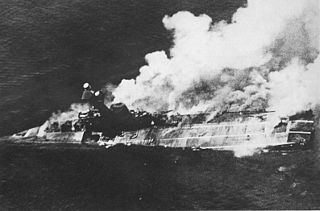
Prior to World War II, the Indian Ocean was an important maritime trade route between European nations and their colonial territories in East Africa, the Arabian Peninsula, British India, Indochina, the East Indies (Indonesia), and Australia for a long time. Naval presence was dominated by the Royal Navy Eastern Fleet and the Royal Australian Navy as World War II began, with a major portion of the Royal Netherlands Navy operating in the Dutch East Indies and the Red Sea Flotilla of the Italian Regia Marina operating from Massawa.
The Italian destroyers of World War II comprised a mix of old warship designs dating from World War I and some of the most modern of their type in the world. These destroyers also varied in size from enlarged torpedo-boats to esploratori.

Salvatore Pelosi was an Italian naval officer who fought in World War II. As commander of the submarine Torricelli he made a gallant last stand against overwhelming British naval forces in June 1940.

The Action in the Strait of Otranto [also the Battle of the Strait of Otranto (1940)] was the destruction of an Italian convoy on 12 November 1940 during the Battle of the Mediterranean in the Second World War. It took place in the Strait of Otranto in the Adriatic Sea, between the Royal Navy and the Italian Royal Navy.

The Adriatic campaign of World War II was a minor naval campaign fought during World War II between the Greek, Yugoslavian and Italian navies, the Kriegsmarine, and the Mediterranean squadrons of the United Kingdom, France, and the Yugoslav Partisan naval forces. Considered a somewhat insignificant part of the naval warfare in World War II, it nonetheless saw interesting developments, given the specificity of the Dalmatian coastline.
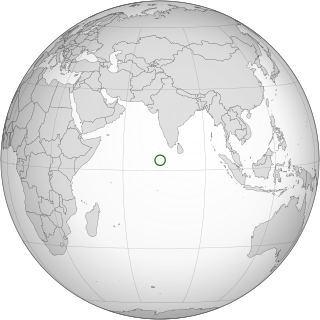
The action of 27 February 1941 was a single ship action between the British cruiser HMS Leander and the Italian auxiliary cruiser Ramb I. It began when Leander ordered an un-flagged freighter to stop for an inspection. The freighter raised the Italian colours and engaged Leander which sank Ramb I shortly after. Most of the Italian crew were rescued and taken to Addu Atoll, thence to Ceylon. Leander patrolled southwards to investigate more reports of commerce raiders.

The Attack on Convoy BN 7 was a naval engagement in the Red Sea during the Second World War between a British force defending convoyed merchant ships and a flotilla of Italian destroyers. The Italian attack failed, with only one merchant ship being slightly damaged. After a chase, the British destroyer HMS Kimberley torpedoed the Italian destroyer Francesco Nullo which was beached on Harmil Island. Kimberley was hit, disabled by Italian shore batteries on the island and towed to safety by the cruiser HMS Leander.

Mario Bonetti was an Italian admiral during World War II.



